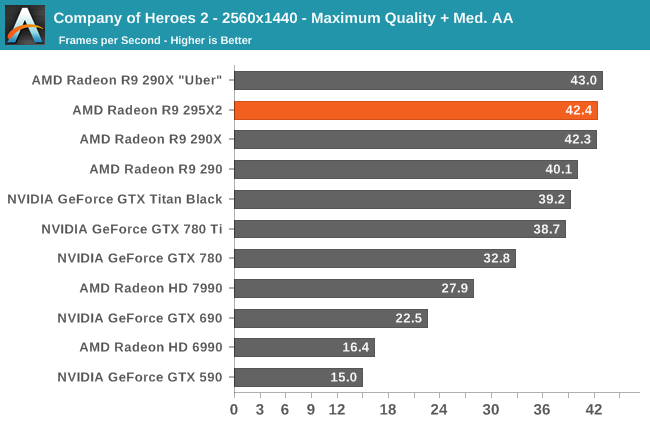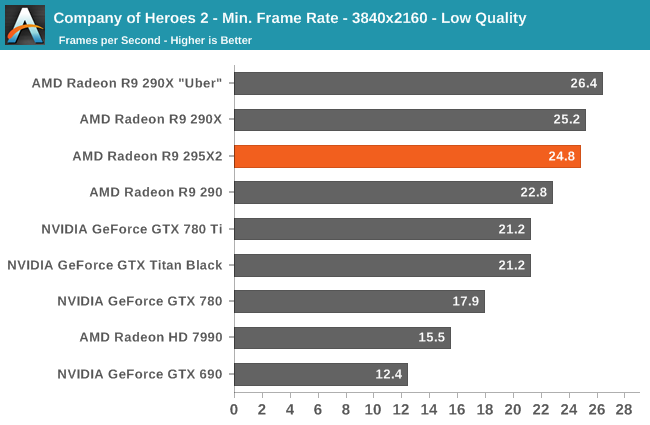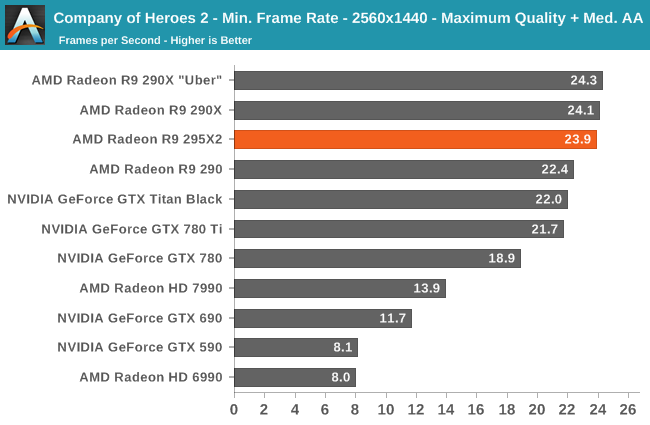The AMD Radeon R9 295X2 Review
by Ryan Smith on April 8, 2014 8:00 AM EST- Posted in
- GPUs
- AMD
- Radeon
- Radeon 200
Company of Heroes 2
Our second benchmark in our benchmark suite is Relic Games’ Company of Heroes 2, the developer’s World War II Eastern Front themed RTS. For Company of Heroes 2 Relic was kind enough to put together a very strenuous built-in benchmark that was captured from one of the most demanding, snow-bound maps in the game, giving us a great look at CoH2’s performance at its worst. Consequently if a card can do well here then it should have no trouble throughout the rest of the game.


Company of Heroes 2’s underlying engine is not AFR friendly, and as a result it receives no gains from the second GPU on the 295X2. This is a subtle but important reminder that although most games benefit from multi-GPU setups, there will always be games like Company of Heroes where it’s not possible to scale beyond a single GPU. Which is why maximizing single-GPU performance first before going wider is the preferred way to improve GPU performance.












131 Comments
View All Comments
Dustin Sklavos - Tuesday, April 8, 2014 - link
Single cable is beyond spec for the connector. We've been hearing connectors actually melting. "Crappy" isn't really relevant here; this is the *only* card on the market that causes these kinds of problems.Anders CT - Tuesday, April 8, 2014 - link
500 watt power consumption is insane. It should come with an on-board dieselgenerator.Blitzninjasensei - Saturday, July 12, 2014 - link
The thought of this made my day. Thanks for the joke, needed it.therfman - Tuesday, April 8, 2014 - link
This is all very nice, but unless case space is at a premium, I fail to see the advantage of this card over two 290X cards with good coolers. The PowerColor PCS+ version of the 290X runs at 1050 MHz, is much quieter than the reference boards (40-42 dBA under load at 75cm), and is available for under $600. Is having a single-slot solution worth $300 extra? Not unless you really want have everything in a small form factor case.Peeping Tom - Tuesday, April 8, 2014 - link
Is that a giveaway I hear coming? ;-)silverblue - Tuesday, April 8, 2014 - link
Please, don't... I don't think I could stand to see a card of this calibre being offered only to those in the States... :|JBVertexx - Tuesday, April 8, 2014 - link
Is there any way to tell the temperatures of each of the two GPUs? Where does the temperature reading for the testing come from - is it an average of the 2, the hotter, or the cooler one?Reason I'm asking is I was skeptical a 120mm rad could effectively cool two of these GPUs. Given they are connected in series, one is bound to be measurably hotter than the other.
Otherwise, this looks to be a winner. I was considering upgrading my uATX rig so I could do SLI. But with this card, I could keep the compact form factor.
JBVertexx - Tuesday, April 8, 2014 - link
After some additional research on the web, it looks like the difference in temps between the 2 GPUs is only about 2 degrees under load, so pleasantly surprised with how well the 120mm radiator handles the cooling.Ryan Smith - Tuesday, April 8, 2014 - link
The temperature readings come from MSI Afterburner, which is capable of reading the temperatures via AMD's driver API. And unless otherwise noted, the temperature is always the hottest temperature.srsbsns - Tuesday, April 8, 2014 - link
The point of this driver was improvements the the HD7000 series and their rebrands... Anandtech missed this by benching an already optimized 290x dual card?